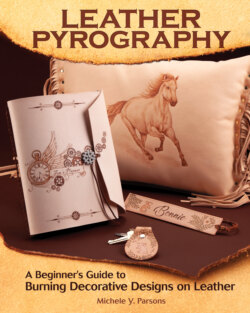Читать книгу Leather Pyrography - Michele Y. Parsons - Страница 6
ОглавлениеINTRODUCTION
After numerous years as a pyrography artist and instructor, one day I finally tried my hand at leather pyrography and was hooked! Burning on leather is very smooth and relaxing when compared to burning on wood and dealing with wood grain. I embraced leather burning and started teaching small classes as an alternative to woodburning classes while I taught at the International Woodcarving Congress, the Southeastern Woodcarving School, and the Fox Chapel Open House. The reaction I most commonly received from students was that burning on leather is like burning on butter. Students seemed to love the freedom from dealing with wood grain that leather allowed. As I continued the pursuit of leather pyrography, I started selling pyrography-suitable leather products in my online store for my students. Then I began to receive inquiries from customers about leather pyrography, and I realized that I couldn’t teach these customers what they needed to know over the phone or through email, especially when they did not have any pyrography experience. That is when I started researching leather pyrography, looking for book or video resources to sell in my online store or to point customers in the direction they needed. However, I found that the information available on leather pyrography is severely lacking—so I decided to write this book.
While deciding what this book would cover, I thought about why leather crafters would want to use pyrography instead of stamping, carving, and modeling leather. I’ve seen beautiful work done using traditional leathercrafting methods to render images on leather. What pyrography brings to the table is the ability to render extremely fine detail and extremely subtle shading on leather. For example, if a feather was created on leather using traditional tooling methods, the lines would typically be cut. But if I burn the same feather on leather, I can use a thin skew tip and burn thin lines that are so close together that I can render a highly realistic feather. Likewise, I can use a shader pen to portray the subtle tones in an eye’s iris to make it appear realistic. Pyrography gives you the ability to create subtleties in your art that other leathercrafts do not.
This book will focus on teaching the basics of pyrography as it applies to leather. I will share with you the methods I use for leather pyrography, but realize there are different methods for accomplishing this art form. After reading this book and trying the techniques and projects, I hope you enjoy leather pyrography as much as I do and continue creating.
Michele Parsons
What’s Pyrography?
Why do I use the “fancy” term pyrography? The word has its roots in the Greek and Latin words of pyro (fire) and graphy (writing/drawing). My pyrography students are very familiar with me getting on my soapbox about the use of this special word. Pyrography means burning patterns, text, or images on a variety of mediums, including but not limited to wood, gourds, leather, cork, canvas, tagua nuts, bone, and paper. One of the most popular mediums that people burn is wood. If a person is burning on wood, then woodburning is a perfectly acceptable word to use. Due to the popularity of woodburning, though, I have heard people refer to “woodburning on leather.” This is definitely a misnomer, but I’ve even seen large companies refer to woodburning on leather, too, because they are aware that the public is not familiar with the term pyrography. It would be proper to say leather pyrography is “burning on leather”— just don’t use the phrase “woodburning on leather.”
